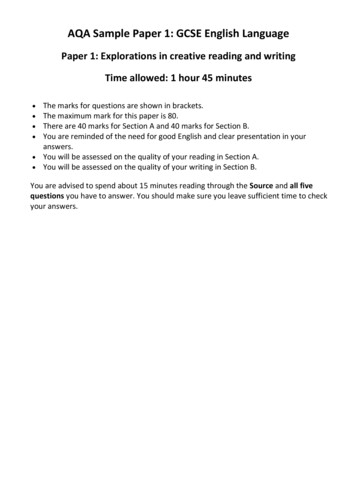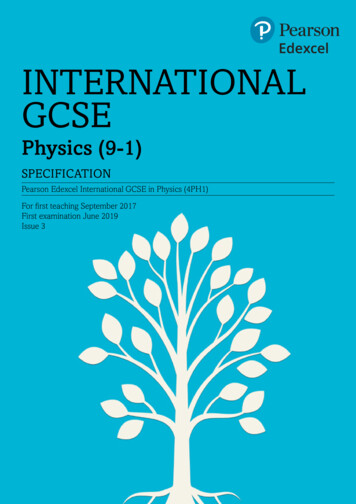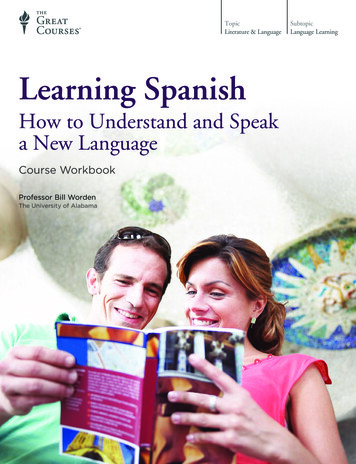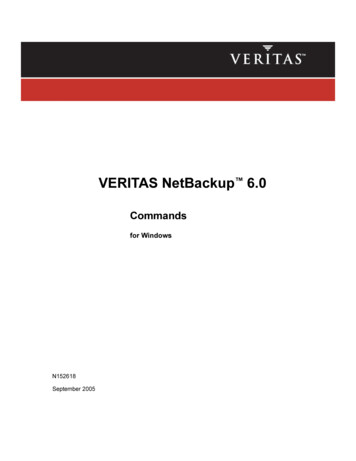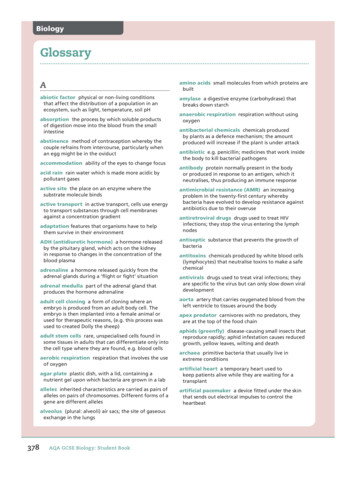
Transcription
BiologyGlossaryAamino acids small molecules from which proteins arebuiltabiotic factor physical or non-living conditionsthat affect the distribution of a population in anecosystem, such as light, temperature, soil pHamylase a digestive enzyme (carbohydrase) thatbreaks down starchabsorption the process by which soluble productsof digestion move into the blood from the smallintestineabstinence method of contraception whereby thecouple refrains from intercourse, particularly whenan egg might be in the oviductaccommodation ability of the eyes to change focusacid rain rain water which is made more acidic bypollutant gasesactive site the place on an enzyme where thesubstrate molecule bindsactive transport in active transport, cells use energyto transport substances through cell membranesagainst a concentration gradientadaptation features that organisms have to helpthem survive in their environmentADH (antidiuretic hormone) a hormone releasedby the pituitary gland, which acts on the kidneyin response to changes in the concentration of theblood plasmaadrenaline a hormone released quickly from theadrenal glands during a ‘flight or fight’ situationadrenal medulla part of the adrenal gland thatproduces the hormone adrenalineadult cell cloning a form of cloning where anembryo is produced from an adult body cell. Theembryo is then implanted into a female animal orused for therapeutic reasons, (e.g. this process wasused to created Dolly the sheep)adult stem cells rare, unspecialised cells found insome tissues in adults that can differentiate only intothe cell type where they are found, e.g. blood cellsaerobic respiration respiration that involves the useof oxygenanaerobic respiration respiration without usingoxygenantibacterial chemicals chemicals producedby plants as a defence mechanism; the amountproduced will increase if the plant is under attackantibiotic e.g. penicillin; medicines that work insidethe body to kill bacterial pathogensantibody protein normally present in the bodyor produced in response to an antigen, which itneutralises, thus producing an immune responseantimicrobial resistance (AMR) an increasingproblem in the twenty-first century wherebybacteria have evolved to develop resistance againstantibiotics due to their overuseantiretroviral drugs drugs used to treat HIVinfections; they stop the virus entering the lymphnodesantiseptic substance that prevents the growth ofbacteriaantitoxins chemicals produced by white blood cells(lymphocytes) that neutralise toxins to make a safechemicalantivirals drugs used to treat viral infections; theyare specific to the virus but can only slow down viraldevelopmentaorta artery that carries oxygenated blood from theleft ventricle to tissues around the bodyapex predator carnivores with no predators, theyare at the top of the food chainaphids (greenfly) disease-causing small insects thatreproduce rapidly; aphid infestation causes reducedgrowth, yellow leaves, wilting and deatharchaea primitive bacteria that usually live inextreme conditionsagar plate plastic dish, with a lid, containing anutrient gel upon which bacteria are grown in a labartificial heart a temporary heart used tokeep patients alive while they are waiting for atransplantalleles inherited characteristics are carried as pairs ofalleles on pairs of chromosomes. Different forms of agene are different allelesartificial pacemaker a device fitted under the skinthat sends out electrical impulses to control theheartbeatalveolus (plural: alveoli) air sacs; the site of gaseousexchange in the lungs378AQA GCSE Biology: Student Book16771 P378 390.indd 37821/01/17 6:06 PM
arteries blood vessels with thick elastic walls thatcarry oxygenated blood away from the heart underhigh pressurebinomial system the scientific way of naming anorganism whereby each organism has a genus nameand a species name; e.g. Homo sapiensaseptic technique measures taken to reducecontamination when preparing bacterial cultures,e.g. working with a flamebiodiversity range of different plant and animalspecies living in an ecosystemasexual reproduction reproduction involving onlyone parentaspirin painkiller derived from willow barkATP molecule used to store energy in the bodyatrium (plural: atria) the upper chambers of theheart that receive blood from the body or lungsautoclave hot oven in which contaminated materialsused in cell culture are sterilisedauxin a type of plant hormone produced at the tipsof plant shoots and rootsBbacteria single-celled microorganisms which caneither be free-living organisms or parasites (theysometimes invade the body and cause disease)bacterial growth curve bell-shaped curve thatshows how bacteria in culture increase in numberexponentially until a build-up of toxins in the culturecauses them to die offbiogas energy released when bacteria break downbiomass, which can be used as a cheap fuel sourcebiomass the dry mass of organismsBiuret reagent chemical indicator used to test forthe presence of protein in a sampleblood sugar level the amount of glucose in theblood (controlled by the hormones, insulin andglucagon)biological catalysts enzymes – molecules in thebody that speed up chemical reactionsbiotechnology using living organisms to makeproducts to improve quality of lifebody mass index (BMI) measure of someone’sweight in relation to their heightbreed new form of animal created with particularcharacteristics, created through selective breedingbronchus (plural: bronchi) branches of thetrachea – one going to each lungCbarrier methods of contraception; where a condomor diaphragm is used to prevent sperm reachingan eggcalibrate the process of checking the accuracy apiece of equipment using standard databasal metabolic rate the level at which chemicalreactions take place in the body at restcamouflage a method of avoiding detection used byprey to avoid predators and by predators to surprisepreybehaviour animals adapt their movement andfeeding patterns according to the conditions of theirenvironmentBenedict’s test a test for sugar in which Benedict’sreagent turns orange-red in the presence of sugarbenign tumour slow-growing, harmless mass of cellsthat can usually be easily removedbias when a data set is inaccurate orunrepresentative; it contains systematic errorsbile an alkaline substance made by the liver andstored in the gall bladder, which emulsifies fat to aiddigestionbiotic factor factors caused by living organisms, suchas food availability and competition between speciesbinary fission the process by which a bacteriumdivides and doubles its numbers, approximatelyevery 20 minutescapillaries small blood vessels that are one cell thickand permeable for diffusion of gases; join arteriesto veinscapillary network tree of capillaries surroundingalveoli that are adapted for efficient gaseousexchangecarbohydrase enzyme that breaks downcarbohydrates into simple sugarscarbohydrates one of the main groups of nutrients;e.g. glucose, starchcarbon cycle a natural cycle through whichcarbon moves by respiration, photosynthesis andcombustion, in the form of carbon dioxidecarbon sink ‘stores’ of carbon dioxide in oceans orforestscarcinogen substance or virus that increases the riskof cancer, e.g. ionising radiationGlossary16771 P378 390.indd 37937921/01/17 6:06 PM
Biologycarrier someone who is heterozygous for a diseasecausing gene so that they do not have the conditionbut ‘carry’ the defective allele, which they could passon to their childrencausal mechanism where a direct link has beenmade between a risk factor and a disease; e.g.smoking and lung cancercell lines cells grown in a lab that are used to study acertain conditioncell membrane layer around a cell which helps tocontrol substances entering and leaving the cellcell cycle a series of three stages during which a celldividescellulose polymer of glucose; strengtheningcomponent of plant cell wallscentral nervous system (CNS) collectively, the brainand spinal cordcerebellum area at the base of the brain thatcoordinates muscular activitycerebral cortex highly folded outer layer of thebrain that controls consciousness, intelligence,memory and languagecervix the neck of the wombCharles Darwin scientist who proposed the theoryof evolution by natural selectionchlorophyll pigment found in plants which is used inphotosynthesis (gives green plants their colour)chloroplast a cell structure found in green plantsthat contains chlorophyllchlorosis when a plant develops yellow leaves due toa lack of magnesiumchromosomes thread-like structures in the cellnucleus that contain DNAcilia tiny hair-like structures found throughout therespiratory system that beat together to move mucusout of the lungsclassify to organise and present data in a logicalorder, e.g. in a tableclinical trial process during which a new drug istested on patients and healthy individualsclone in asexual reproduction, the offspringproduced are identical to the parent (clones)collision theory an explanation of enzyme action;enzymes cause more collisions between reactantsthereby increasing the rate of reaction untilreactants are used upcolony a spot containing millions of bacteria growingon an agar plate380combined contraceptive pill a hormonal methodof contraception, taken orally, which containssynthetic forms of oestrogen and progesteronecommunicable disease infectious condition causedby a virus, protist, bacteria or fungi; e.g. measles, HIVcommunity all the plants and animals living in anecosystem, e.g. a gardencompanion cells found next to phloem cells,companion cells control the activities of the phloemcompare to examine your data set next to a knownset of resultscompetition when different species in an ecosystemcompete for the same resourcescomplementary describes how each DNA strand in adouble helix pairs with the opposite strand throughbase pairs (A-T and G-C)complex diseases conditions that are caused by acombination of genetic and environmental factorscompost dead and decaying plant materialcondom rubber sheath that covers the erect penisand prevents sperm reaching the egg; a barrier formof contraceptioncones light-sensitive receptor cells in the retina thatallow us to see in colourconservation a way of protecting a species orenvironmentcooling the body loses heat through sweatingcoordination centre region of the body that receivesand processes information from receptors, e.g. brain,pancreascornea transparent region at the front of the eyethrough which light refracts when it enters the eyecoronary artery vessel that provides the heartmuscle with oxygen and glucose for respirationcoronary heart disease a condition caused by buildup of fatty deposits in the coronary artery, leadingto reduced blood flow and less oxygen and glucosereaching the heart tissue, which can cause a heartattackcorrelation relationship between two sets of resultsculture the growing of cells in a labculture medium the liquid (nutrient broth) or gel(agar) in which bacteria are grown in a labculture solutions liquids with known amountsof specific minerals in which plants are grown toinvestigate mineral deficienciescycle predator–prey relationships follow a cyclicalpattern whereby the numbers of prey rise and fallAQA GCSE Biology: Student Book16771 P378 390.indd 38021/01/17 6:06 PM
over a period of years, and the numbers of predatorsfollow the same patterncystic fibrosis disorder of cell membranes that iscaused by a recessive alleleDdaughter cells cells produced during mitosis that areidentical to the parent celldeamination the removal of amino groups, asammonia, from excess amino acids, in the liverdecomposer an organism that breaks down carbonin dead animals and plantsdeforestation removal of large areas of trees toprovide land for cattle or growing cropsdehydration result of the body losing too muchwaterdemographic describes the structure of a populationdenatured an enzyme is denatured if its shapechanges so that the substrate cannot fit into theactive sitedomain the level of classification group abovekingdom, first suggested by Carl Woesedominant an allele that is expressed when one ortwo copies are present; represented by a capitalletterdominant hand the hand a person uses most oftenfor single-handed tasks, e.g. writingdonor refers to the person or organism wheredonated cells or tissue come fromdormant describes seeds that have not germinated;they can be sprayed with the plant hormonegibberellins, which induces them to germinatedose amount of a drug given to a patientdouble-blind trial a drugs trial where neitherdoctors nor patients know whether the patient hasreceived the test drug or the placebodouble circulatory system where the blood ispumped to the lungs then returned to the heartbefore being pumped round the bodydepression a mental health conditiondouble helix the shape of DNA – two strands ofnucleotides that wind around each other like atwisted ladderdialysis process by which the blood is filtered by adialysis machine, in someone with kidney failuredredging the process of digging up sea beds; anexample of environmental change induced by humansdiarrhoea a symptom of food poisoning; frequentpassing of liquid stoolsdual bar chart bar graph on which two data sets areplotted at each pointdifferentiation when cells gain certain featuresneeded for their function; they become specialisedEdigitalis a heart drug extracted from foxglovesEbola a deadly virus that kills 50–90% of peopleinfecteddirectly proportional describes a relationshipbetween two variables on a graph where the line ofbest fit goes through 0,0disc-diffusion technique used to test effectivenessof antibiotics or disinfectants on plates of culturedbacteria using paper discs soaked in the testsubstance and measuring the size of clear areaaround the discsdisease resistance crop plants that are not affectedby certain diseases and can therefore be cloned inlarge numbers for farmersdistribution how living organisms are dispersed/spread out over an ecosystemDNA (deoxyribonucleic acid) found as chromosomesin the nucleus – its sequence determines how ourbodies are made, and gives each one of us a uniquegenetic codeDNA bases four chemicals that are found in DNA,they make up the base sequence and are given theletters A, T, G and Cecosystem the interaction of a community ofliving organisms with the non-living parts of theirsurroundingseffector muscle or gland that brings about aresponse to a stimulusefficacy how effective a drug is at preventing orcuring the diseaseembryonic stem cells unspecialised cells found inthe early embryo that can differentiate into almostany cell type in the bodyembryo screening the process whereby a few cellsare taken from an embryo produced by IVF arechecked for any defective genesembryo transplants form of cloning where cells aretaken from a developing embryo from a pregnantanimal, separated and grown in culture thenimplanted into host mothersemulsify the process by which fats are broken intosmaller droplets by bileGlossary16771 P378 390.indd 38138121/01/17 6:06 PM
Biologyendocrine gland part of the body that releaseschemical messengers, or hormones, directly into thebloodstreamendocrine system a control system in the bodythat communicates using chemical messengers, orhormones, to produce slow but long-lasting responsesextinction the elimination of all members of aspecies; there have been five mass extinctions overgeological timeendothermic reaction chemical reaction whichtakes in heatextracellular digestion referring to when foodis broken down outside an organism, e.g. bacteriasecrete enzymes to breakdown dead materialenvironmental change a shift in the externalconditions caused by human activity or a naturaleventextremophile organisms that can survive veryextreme environments, e.g. high temperature orhigh saltenvironmental variation differences betweenindividuals that arise during development; e.g.wearing glassesFenzymes biological catalysts that increase the speedof a chemical reactionfactory farming a form of intensive farming whereanimals are reared in sheds or cages under controlledconditionsepidemic an outbreak of a disease that spreadsquickly to many peoplefamily tree a diagram used to show how a conditionis passed down through a familyepidermal tissues layers of cells that cover the topsurface of a leaf; they let light penetratefermentation anaerobic respiration in yeast cells;produces ethanol and carbon dioxideepiphyte rainforest plant that is adapted to growabove ground level (e.g. on trees)fertiliser chemical containing minerals (nitrates,phosphates, potassium and magnesium) put on soilto improve plant growthestimate a guess based on prior knowledgeethanol product of anaerobic respiration in plantand yeast cells; used in the manufacture of alcoholicdrinksethene a plant hormone released as a gas thatspeeds up fruit ripeningethical whether a process is considered to be right orwrong, based on moral considerationseugenics refers to the notion of improvinga population by selecting certain desirablecharacteristicsfertility drug combination of hormones givento a woman with low FSH levels to stimulate eggproductionfield of view the area of a sample visible under amicroscopefiltrate dissolved substances that cross into thekidney after the blood has been filteredflaccid floppyfollicle the sac left once an egg is released in theovary; it produces the hormone progesteroneeukaryotic cells cells that contain a true nucleus inthe cytoplasm; e.g. plant and animal cellsfood security when all people have access to aconsistent supply of food to meet their needseutrophication when waterways become too richwith nutrients (from fertilisers), allowing algae togrow wildly and subsequently decay, resulting in theoxygen being used upfossil the remains of organisms that lived millions ofyears agoevaporation the process by which the body losesheat through sweatingevolution the gradual change in organisms overmillions of years caused by random mutations andnatural selectionevolutionary tree a diagram created by scientiststhat shows how animals are believed to have evolvedfrom common ancestorsexchange surfaces specialised areas with largesurface area to volume ratios for efficient diffusion382exothermic reaction chemical reaction in whichheat is given outfossil record an incomplete account of organismsthat lived millions of years agofraction (in genetics) the number of people affectedby a recessive condition expressed as a fraction couldbe 1/4FSH (follicle stimulating hormone) a reproductivehormone that causes eggs to mature in the ovariesfunctional adaptation an adaptation involving howthe body operates, e.g. camels don’t sweat to avoidwater lossfungicide chemical used to kill fungiAQA GCSE Biology: Student Book16771 P378 390.indd 38221/01/17 6:06 PM
Gglobal warming the increase in the Earth’stemperature due to increases in carbon dioxide levelsgametes the male and female sex cells (sperm andeggs)glucagon hormone released by the pancreas that,along with insulin, controls blood glucose levelsgel derived from silicone, the material that contactlenses are made fromglucose tolerance test a way of testing for diabetesby measuring how the body responds to glucosegene section of DNA that contains the instructionsfor a particular characteristicGM crops varieties of crops that have had theirgenomes modified by the insertion of genes from aplant or other organismgene expression whether genes are switched on oroff, which is regulated by non-coding DNAgenerator large tanks full of rotting organic matter,used for biogas productiongene theory dogma developed in the twentiethcentury that brought together the work of manyscientists on inheritance, DNA structure and thegenetic codegene therapy medical procedure where a virus isused to ‘carry’ a gene into the nucleus of a cell (this isa new treatment for genetic diseases)genetic code a sequence of three DNA bases thatcodes for a single amino acidgenetic cross a way of working out the probabilityof the genotype of the offspring produced from theparents’ genotype for a particular characteristic, e.g.using a Punnett squaregoblet cells cells in the epithelium that producemucus to trap dust particlesgolden rice rice that has been genetically modifiedto contain β - carotene, which converts to vitamin Agonorrhoea a sexually transmitted disease caused bybacteria, resulting in pain when urinating and a thickdischarge from the vagina or penisgradient the steepness of a line plotted on a graphgraticule piece of glass or plastic onto which a scalehas been drawn, which is used with a microscopeGregor Mendel Austrian monk who established thescience of genetics through his work on pea plantsguard cells cells surrounding the stomata thatopen and close the pore to control the exchange ofgases and water lossgenetic engineering transfer of specific genes fromone organism to anotherHgenetic marker gene a gene inserted into amodified organism alongside the required gene;the marker gene is often resistant to an antibiotic,so that when cultures of cells are treated with thatantibiotic, cells that do not contain the marker genewill be killedhabitat the place where an organism lives in anecosystem; e.g. the worm’s habitat is the soilgenetic variation the product of meiosis, mutationsand sexual reproduction, which all lead to changes inour genomegenome the entire genetic material of an organismhaemocytometer device used for counting thenumber of cells, e.g. under a microscopehaemodialysis filtering of the blood by a machine inpatients with kidney failure; takes four hours, threetimes a weekhaemoglobin chemical found in red blood cellswhich binds to oxygen to transport it around thebodygenome editing an experimental method ofdetecting and correcting defective genes in anindividualhealth a state of compete mental and physicalwellbeinggenomics the science of studying the human genometo increase our understanding of human DNAheterozygous a person who has two different allelesfor a characteristic, e.g. someone with blond hairmay also carry the allele for red hairgenotype the alleles present for a particular genemake up the organism’s genotypegeotropism a plant’s growth response to gravity(also called gravitropism)gibberellins plant hormones that speed up seedgerminationgills a gas exchange surface found in fish andtadpolesHIV (human immunodeficiency virus) virustransmitted through sexual contact that attacks theimmune systemhomeostasis the regulation of internal conditions,such as temperature, in the bodyhomozygous a person who has two alleles that arethe same for a characteristic, e.g. a blue-eyed personwill have two ‘blue’ alleles for eye colourGlossary16771 P378 390.indd 38338321/01/17 6:06 PM
Biologyhormone chemical messenger that acts on target H1 EM organs in the bodyhybrid infertile organism created throughinterbreeding organisms from two different specieshybridomacells madecombiningabsorbtakecellsin or soakup, forfromexampleenergy fromtumour cells with lymphocytes, to give cells that cansoundproduce antibodies and divide (for the production of txtGlss wrd TXT GLSS monoclonal antibodies)hydrocarbon a compound composed of theelements hydrogen and carbonhydroponics growing plants in mineral solutionswithout the need for soilhyperopia long-sightedness; where people can seeobjects far away but not close uphypothesis a scientific explanation formed based onprior knowledge that can be tested in an experimentIimmune system the body’s defence againstpathogensimmunity when the body is protected from apathogen as it has already encountered it and cantherefore produce antibodies against it, rapidlyinbreeding breeding closely related animalsincubation period of time a culture of bacteria is left ata certain temperature in order for the bacteria to growin-vitro fertilisation (IVF) a fertility treatment,whereby an egg is fertilised with sperm outside thebody, in a laboratoryiodine solution an orange solution used to test forstarch (turns blue-black when starch is present)iris part of the eye that has sets of muscles thatcontrol the size of the pupil and regulate the lightreaching the retinaIUD (intrauterine device) a device containing hormonesthat is placed in the uterus to prevent a fertilised eggfrom implanting; a hormonal method of contraceptionIVF cycle the process of IVF from stimulationof the ovaries to implantation of an embryo; ifunsuccessful, another cycle can be attempted afterabout two monthsKkingdom the level of classification above phylum andbelow domain of living organismsLlactic acid product of anaerobic respiration in musclesindicator species organisms used to measure thelevel of pollution in water or the airlarva immature but active form of an insect that’screated from an egg and turns into a pupainoculating loop length of wire with a ring at theend used for transferring bacteria to an agar platelaser surgery a technique used to correct eyedefects by changing the shape of the corneainsulin hormone made by the pancreas that controlsthe level of glucose in the bloodLH (luteinising hormone) a menstrual cycle hormonethat stimulates an egg to be released from an ovaryinterbreeding organisms of the same species caninterbreed to give fertile offspringlichen slow-growing plant that grows up treesintercept the point where the line on a graph crossesthe y-axisinterdependence plants need animals for carbondioxide and seed dispersal; animals need plants forfood and oxygen; i.e. they depend on each other forsurvivalinterspecific competition competition betweentwo different species of organismintraspecific competition competition amongorganisms from the same speciesinvasive species a cause of extinction as a result ofa new species of organism being introduced into apopulation, which may bring disease, be a predatoror compete with native organisms384inverse square law (in terms of light intensity andphotosynthesis) the intensity of light is proportionalto 1/d2 (where d distance from the light source);for example, if the distance is doubled, the lightintensity is quarteredlignin substance found in some plant cell walls thatgives them strength and rigiditylimiting factor factors such as light, temperatureand carbon dioxide, which affect the rate ofphotosynthesislipases enzymes that digest fats into fatty acids andglycerollock and key theory to explain how enzymes work;the substrate is the ‘key’ and the active site is the ‘lock’lumen the central part of a vessellymphatic system network of vessels containing acolourless fluid into which fatty acids and glycerolare absorbedlymphocytes white blood cells that produceantibodies and antitoxins to destroy pathogensAQA GCSE Biology: Student Book16771 P378 390.indd 38421/01/17 6:06 PM
Mmineral deficiency when a plant cannot get enoughof an essential mineral from the soilmagnetic resonance imaging (MRI) scanningtechnique that uses strong magnetic fields toproduce detailed images of the body; used todiagnose nervous system disordersmineral ions substances found in the soil that areessential for a plant’s survival; e.g. plants needmagnesium ions to make chlorophyllmagnification the factor by which an object isenlarged by a microscope; calculated as: size ofimage/size of real objectmalaria condition characterised by recurring fever,which is spread by mosquitoes and can be fatalmalignant tumour abnormal cancerous mass of cellsthat grows quickly and can spread to other parts ofthe bodymathematical model an independent method usedto show that Mendelian genetics is consistent withevolutionmedian the middle number in a set of values whenthey are arranged in order from lowest to highestmedulla region at the base of the brain that controlsunconscious activities, such as breathingmean average value calculated by adding up all thevalues in a data set then dividing by the number ofvaluesmeiosis cell division that results in gametes beingproduced, with half the number of chromosomes asthe parent cellmelanism darkening of appearance – a form ofcolour variation in animals, e.g. melanic mothsMendelian inheritance name given to single-genedisorders, such as cystic fibrosismenstrual cycle monthly cycle in females which iscontrolled by reproductive hormonesmental health a feeling of well-being, having apositive frame of mindmeristem regions at tips of roots and shoots wherecell division takes placemetabolism the sum of all reactions in a cell orthe bodymicrograph image captured using a microscopemicroorganisms tiny organisms that can only beviewed with a microscope – also known as microbesmigration patterns historical movements of humansacross the world, which have been deduced throughstudying genomesmimicry mechanical defence mechanism where aplant uses features to trick animals into not feedingor not laying eggsmissing links evidence for evolution found asintermediate forms between different organisms, asthey evolvedmitochondria structures in a cell where respirationtakes placemitosis cell division that results in geneticallyidentical diploid cellsmixed population plants bred from two differentvarieties for their desirable traitsmode the most frequently occurring number in a setof valuesmonoclonal antibodies antibodies made fromcells that are cloned from one cell that are specificto one binding site on an antigen. They are used inmedicine to treat cancer, and in researchmonocultures where only one crop is grown in anareamotor neurone nerve cell carrying information fromthe central nervous system to musclesMRSA bacteria that are resistant to the antibiotic,methicillinmulch compost or decaying leaves put around rosebushes in the spring to prevent rose black spotspores reaching the stemsmutation where the DNA within cells has beenaltered (this happens in cancer)mycoprotein a protein-rich food made frommicroorganisms in fermentation vatsmyelin sheath a fatty insulating layer that surroundsneurones and speeds up nerve transmissionmyopia short-sightedness; when people can seeobjects at short distances but not far awayNnatural selection process by which advanta
Biology 16771_P378_390.indd 380 21/01/17 6:06 PM. Glossary 381 over a period of years, and the numbers of predators follow the same pattern cystic fibrosis disorder of cell membranes that is caused by a recessive allel
